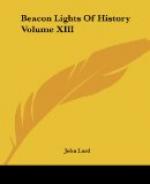I cannot quit this part of Carlyle’s life without mention of what I conceive to be his most original and remarkable production,—“Sartor Resartus,”—The Stitcher Restitched: or, The Tailor Done Over,—the title of an old Scotch song. It is a quaintly conceived reproduction of the work of an imaginary German professor on “The Philosophy of Clothes,”—under which external figure he includes all institutions, customs, beliefs, in which humanity has draped itself, as distinguished from the inner reality of man himself. “The beginning of all Wisdom,” he says, “is to look fixedly on Clothes, or even with armed eyesight, till they become transparent.” And thus, in grotesque fashion, with amazing vigor he ranges the universe in search of the Real. In one of his letters to Emerson, Carlyle, discussing a project of lecturing in America, takes on his sartorial professor’s name, and writes: “Could any one but appoint me Lecturing Professor of Teufelsdroeckh’s Science,—’Things in General’!” This work was written in his remote solitude, yet not published for years after it was finished,—and for the best of reasons, because with all his literary repute Carlyle could not find a publisher. The “Sartor” was not appreciated; and Carlyle, knowing its value, locked it up in his drawer, and waited for his time.
The “Sartor Resartus” is a sort of prose poem, written with the heart’s blood, vivid as fire in a dark night; a Dantean production; a revelation probably of the author’s own struggles and experiences from the dark gulf of the “Everlasting Nay” to the clear and serene heights of the “Everlasting Yea.” To me the book is full of consolation and encouragement,—a battle of the spirit with infernal doubts, a victory over despair, over all external evils and all spiritual foes. It is also a bold and grotesque but scorching sarcasm of the conventionalities and hypocrisies of society, and a savage thrust at those quackeries which seem to reign in this world in spite of their falsity and shallowness. It is not, I grant, easy to read. It is full of conceits and affectations of style,—a puzzle to some, a rebuke to others. “Every page of this unique collection of confessions and meditations, of passionate invective and solemn reflection,” is stamped with the seal of genius, and yet was the last of Carlyle’s writings to be appreciated. I believe that this is the ordinary fate of truly original works, those that are destined to live the longest, especially if they burn no incense to the idols of prevailing worship, and be characterized by




